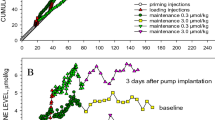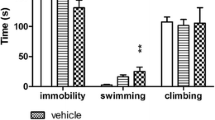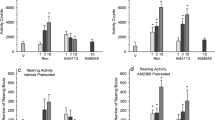Abstract
Two initial studies investigated: i) the effects of withdrawal from ipsapirone [a putative non-benzodiazepine (BZ) anxiolytic] and chlordiazepoxide (CDP); and ii) effects of ipsapirone in animals withdrawn from CDP. Rats were injected b.i.d. for 21 days with saline, ipsapirone or CDP at doses up to 40 mg/kg/injection. Subsequently, controls received the treatment administered previously, other subjects received saline during withdrawal from ipsapirone or CDP. Further subjects received ipsapirone (3, 10 or 30 mg/kg b.i.d.) during CDP withdrawal. Withdrawal indices recorded were body weight and food intake. Withdrawal signs were absent after ipsapirone treatment but present after CDP treatment, when food intake and bodyweight measures fell and then recovered. At the high dose of 30 mg/kg (b.i.d.) ipsapirone potentiated CDP withdrawal signs. Potentiation of withdrawal wasnot seen in animals treated with ipsapirone at lower doses (3 and 10 mg/kg, b.i.d.). In a subsequent study we found that ipsapirone conditioned a taste aversion, a possible index of drug-induced “malaise”, at doses as low as 7.5 mg/kg. Therefore a possible explanation for the potentiation of BZ withdrawal in subjects treated with high doses of ipsapirone was that drug-induced “malaise” reduced food intake and body weight, rather than ipsapirone causing true potentiation of BZ withdrawal. However, in a further study we showed that the ipsapirone treatment regime which potentiated BZ withdrawal didnot significantly reduce food intake or body weight, suggesting that high doses of ipsapirone potentiate BZ withdrawal by a mechanism that does not simply involve “malaise”. The most plausible account of the observed potentiation of withdrawal by ipsapirone involves actions of the ipsapirone metabolite (1-(2-pyrimidinyl)-piperazine) on alpha2-adrenoceptors, which are known to be implicated in BZ withdrawal. However, the precise mechanism involved remains unclear. Collectively, the studies reported show that ipsapirone does not induce the type of withdrawal signs seen with BZs. However, there was no evidence that ipsapirone attenuated BZ withdrawal. It is therefore likely that patients withdrawn from BZs will experience withdrawal if treated with ipsapirone, and that if treated with high doses withdrawal may be exacerbated.
Similar content being viewed by others
References
Ashton CH, Rawlins MD, Tyrer SP (1989) A double-blind placebo controlled study of buspirone in diazepam withdrawal in chronic benzodiazepine users. J Psychopharmacol 3:90P
Baldwin HA, Hitchcott PK, File SE (1989) Evidence that the increased anxiety detected in the elevated plus-maze during chlordiazepoxide withdrawal is not due to enhanced noradrenergic activity. Pharmacol Biochem Behav 34:931–933
Costall B, Jones BJ, Kelly ME, Naylor RJ, Oakley NR, Onaivi ES, Tyers MB (1989) The effects of ondansetron (GR38032F) in rats and mice treated subchronically with diazepam. Pharmacol Biochem Behav 34:769–778
Csanalosi I, Schweizer E, Case WG, Rickels K (1987) Gepirone in anxiety: a pilot study. J Clin Psychopharmacol 7:31–33
Dourish CT (1987) Brain 5-HT1A receptors and anxiety. In: Dourisch CT, Ahlenius S, Hutson PH (eds) Brain 5-HT1A receptors. Ellis Horwood, Chichester, pp 261–277
Dourish CT, Hutson PH, Kennett GA, Curzon G (1986) 8-OH-DPAT-induced hyperphagia: its neural basis and possible therapeutic relevance. Appetite [Suppl] 7:127–140
Dourish CT, Cooper SJ, Gilbert F, Coughlan J, Iversen SD (1988) The 5-HT1A agonist 8-OH-DPAT increases consumption of palatable wet mash and liquid diets in the rat. Psychopharmacology 94:58–63
Duka T, Ackenheil M, Noderer J, Doenicke A, Dorow R (1986) Changes in noradrenaline plasma levels and behavioural responses induced by benzodiazepine agonists with the benzodiazepine antagonist Ro 15-1788. Psychopharmacology 90:351–357
Eison MS (1986) Lack of withdrawal signs of dependence following cessation of treatment or Ro-15,1788 administration to rats chronically treated with buspirone. Neuropsychobiology 16:15–18
File SE (1990) The history of benzodiazepine dependence: a review of animal studies. Neurosci Biobehav Rev (in press)
Gilbert F, Dourish CT (1987) Effects of the novel anxiolytics gepirone, buspirone and ipsapirone on free feeding and on feeding induced by 8-OH-DPAT. Psychopharmacology 93:349–352
Goa KL, Ward A (1986) Buspirone. A preliminary review of its pharmacological properties and therapeutic efficacy as an anxiolytic. Drugs 32:114–129
Goudie AJ (1987) Aversive stimulus properties of drugs: the conditioned taste aversion paradigm. In: Greenshaw AJ, Dourish CT (eds) Experimental psychopharmacology. Humana Press, Clifton, New Jersey, pp 341–391
Goudie AJ, Leathley MJ, McNally J (1989a) Comparative effects on body weight, food intake and temperature of withdrawal from ipsapirone and chlordiazepoxide in rats. Br J Pharmacol 89:244P
Goudie AJ, Leathley M, Deans C, Taylor MAI (1989b) Tolerance to the behavioural effects of the selective 5-HT1A agent, ipsapirone. Behav Pharmacol 1:33–44
Goeders NE, Ritz MC, Kuhar MJ (1988) Buspirone enhances benzodiazepine receptor binding in vivo. Neuropharmacology 27:275–280
Harto NE, Braconnier RJ, Spera KF, Dessain EC (1988) Clinical profile of gepirone, a nondbenzodiazepine anxiolytic. Psychopharmacol Bull 24:154–160
Hitchcott PK, File SE, Ekwuru M, Neal MJ (1990) Chronic diazepam treatment in rats causes long-lasting changes in central [3H]-5-hydroxytryptamine and [14C]-gamma-aminobutyric acid release. Br J Pharmacol 99:11–12
Hutson PH, Donohoe TP, Curzon G (1987) Hypothermia induced by the putative 5-HT1A agonists LY 165163 and 8-OH-DPAT is not prevented by 5-HT depletion. Eur J Pharmacol 143:221–228
Jacobson AF, Dominguez RA, Goldstein BJ, Steinbook RM (1985) Comparison of buspirone and diazepam in generalized anxiety disorder. Pharmacotherapy 5:290–296
Johnston AL, Baldwin HA, File SE (1988) Measures of anxiety and stress in the rat following chronic treatment with yohimbine. J Psychopharmacol 2:33–38
Kennett GA, Marcou M, Dourish CT, Curzon G (1987) Single administration of 5-HT1A agonists decrease 5-HT1A presynaptic but not postsynaptic receptor-mediated responses; Relationship to antidepressant-like action. Eur J Pharmacol 138:53–60
Kunchandy J, Kulkarni SK (1986) Reversal by alpha-2 agonists of diazepam withdrawal hyperactivity in rats. Psychopharmacology 90:198–202
Leathley M, Taylor MAI, Goudie AJ (1990) Effects of the 5-HT3 antagonist, GR38032F, on benzodiazepine withdrawal in rats. Bri J Pharmacol 99:243 P
Neiswander JL, McDougall SA, Bowling SL, Bardo MT (1990) Conditioned taste aversion and place preference with buspirone and gepirone. Psychopharmacology 100:485–490
Nutt DJ, Cowan PJ (1987) Diazepam alters brain 5-HT function in man: implications for the acute and chronic effects of benzodiazepines. Psychol Med 17:601–607
Petursson H, Bond PA, Smith B, Lader MH (1983) Monoamine metabolism during chronic benzodiazepine treatment and withdrawal. Biol Psychiatry 18:207–213
Redmond DE, Huang YH (1987) New evidence for a locus coeruleus norepinephrine connection with anxiety. Life Sci 25:2149–2162
Robinson DS (1990) Buspirone in the treatment of anxiety. In: Tunnicliff G, Eison AS, Taylor DP (eds) Buspirone: mechanism and clinical aspects. Academic Press, La Jolla, California (in press)
Sanghera MK, Coke JA, Williams H, McMillen BA (1990) Ipsapirone and 1-(2-pyrinmidinyl)-piperazine increase rat locus coeruleus noradrenergic activity. Br Res Bull 24:17–22
Schweizer E, Rickels K (1986) Failure of buspirone to manage benzodiazepine withdrawal. Am J Psychiatry 143:1590–1592
Schweizer E, Rickels K, Lucki I (1986) Resistance to the anti-anxiety effects of buspirone in patients with a history of benzodiazepine use. N Engl J Med 314:719–720
Simpson MA, Schoeman HS, Allmann BJC (1989) A profile of buspirone in the treatment of anxiety in general practice patients. Curr Ther Res 46:980–992
Spencer DG, Traber J (1987) The interoceptive discriminative stimuli induced by the novel putative anxiolytic TVX Q 7821: behavioural evidence for the specific involvement of 5-HT1A receptors. Psychopharmacology 91:25–29
Taylor DP (1988) Buspirone, a new approach to the treatment of anxiety. FASEB J 2:2445–2452
Taylor DP, Allen LE, Becker JA, Crane M, Hyslop DK, Riblet LA (1984) Changing concepts of the biochemical action of the anxioselective drug, buspirone. Drug Dev Res 4:95–108
Traber J, Glaser T (1987) 5-HT1A receptor-related anxiolytics. TIPS 8:432–437
Witkin JM, Barrett JE (1986) Interaction of buspirone and dopaminergic agents on punished behavior of pigeons. Pharmacol Biochem Behav 24:751–756
Woods JH, Katz JL, Winger G (1987) Abuse liability of benzodiazepines. Pharmacol Rev 39:251–419
Wree A, Zilles K, Schleicher A, Horvarth E, Traber J (1987) Effect of the 5-HT1A receptor agonist ipsapirone on the local cerebral glucose utilization of the rat hippocampus. Brain Res 436:283–290
Young R, Urbanic A, Emrey TA, Hall PA, Metcalf G (1987) Behavioural effects of several new anxiolytics and putative anxiolytics. Eur J Pharmacol 143:361–371
Author information
Authors and Affiliations
Additional information
An abstract report of some of the data reported here has been published previously (Goudie A.J., Leathley M., McNally J. (1989a))
Rights and permissions
About this article
Cite this article
Goudie, A.J., Leathley, M.J. Evaluation of the dependence potential of the selective 5-H1A agonist ipsapirone in rats and of its effects on benzodiazepine withdrawal. Psychopharmacology 103, 529–537 (1991). https://doi.org/10.1007/BF02244254
Received:
Revised:
Issue Date:
DOI: https://doi.org/10.1007/BF02244254




